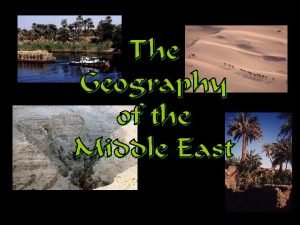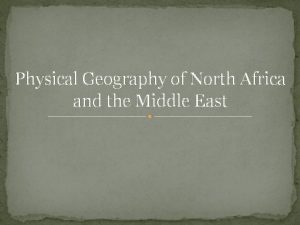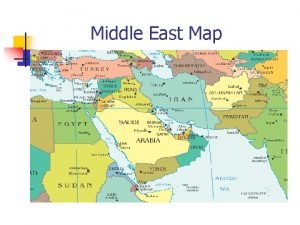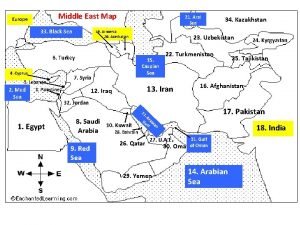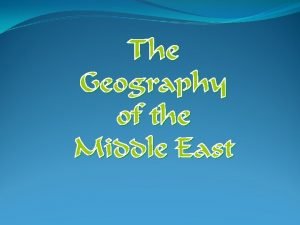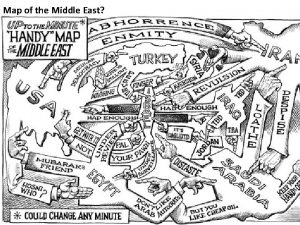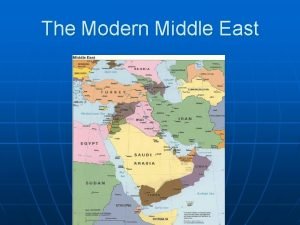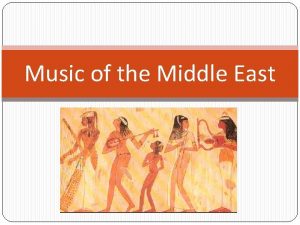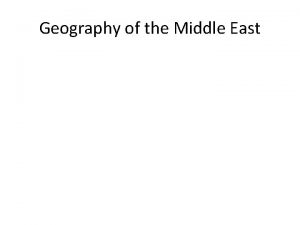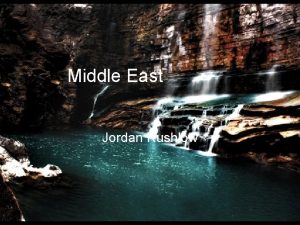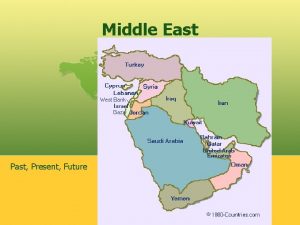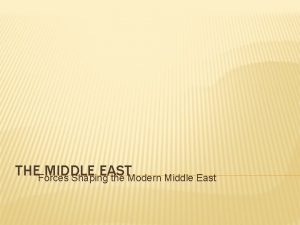Middle East Map Set Goals This set of














- Slides: 14

Middle East Map Set Goals: This set of maps focuses on the Middle East, and we use it to analyze the relationship between natural environment (precipitation especially) and development of early civilizations (emphasizing large ancient cities). We focus on two GLCEs: 7 – W 1. 2. 1 Explain the importance of the natural environment in the development of agricultural settlements in different locations (e. g. , available water for irrigation, adequate precipitation, and suitable growth season). 7 – W 2. 1. 2 Use historical and modern maps and other sources to locate, describe and analyze major river systems and discuss the ways these physical settings supported permanent settlements, and development of early civilizations (Tigris and Euphrates, Yangtze, Nile, Indus Rivers). Maps in the Middle East Map Set Power. Point: Precipitation Basemap Ancient Cities Maps: (cities in relation to precipitation) 3000 – 2500 BCE, 2200 – 1800 BCE, 1400 – 1200 BCE, 600 – 400 BCE, 100 BCE – 100 CE Elevation Basemap Satellite Image Basemap Outline Map (current country borders, rivers) Note: The Michigan Geographic Alliance holds the copyright for these maps. Teachers may use them freely for classroom use.

Suggested Activities Using Maps in the Middle East Map Set: 1. Precipitation Basemap 1 a. Animated labels provide review of names of seas and major rivers. The footnote at bottom names deserts. 1 b. Point out that minimum precipitation is needed to raise different types of crops; see the green explanation box placed near the precipitation legend. For example, wheat farming needs 600 mm (24 inches) of annual rainfall, and millet or barley needs 400 (16 inches). 2. Ancient Cities Maps: (cities in relation to precipitation) 3000 – 2500 BCE, 2200 – 1800 BCE, 1400 – 1200 BCE, 600 – 400 BCE, 100 BCE – 100 CE Note that cities are usually located on rivers or in moderate (green) precipitation regions. 3. Elevation Basemap and Satellite Image Basemap: Note that rivers begin in higher elevations (which also have at least moderate precipitation). Students could mark the source of each river with an “S. ” 4. Country Outline Map: The last slide outlines assessment activities about Rivers and Ancient Cities. Student may also use the outline map to take notes.

Precipitation Basemap Caspian Black Sea K. u. D ay ra R. es at Indus R. ris Tig r ph S. Eu Mediterranean Sea Am R. L. A. Ni le R. T. 200 – 400 mm: grazing 400 – 600 mm: millet , barley 600 – 1000: wheat Copyright: Michigan Geographic Alliance June 2013, contact pgersmehl@gmail. com. Deserts: L. = Libyan (part of Sahara), A. =Arabian, S. =Syrian, K. =Karakum, T. =Thar

Elevation Basemap Am u. D ay ria R. es at Ni le R. Indus R. ris Tig r ph Eu Copyright: Michigan Geographic Alliance June 2013, contact pgersmehl@gmail. com. R.

Satellite Image Basemap Am u. D ay ria R. R. Ni le R. es at Indus R. ris Tig r ph Eu Copyright: Michigan Geographic Alliance June 2013, contact pgersmehl@gmail. com. R.

Ancient Cities, 3000 – 2500 BCE Memphis (Nile R. ), Eridu (Euphrates R. ) Copyright: Michigan Geographic Alliance June 2013, contact pgersmehl@gmail. com.

Ancient Cities, 2200 – 1800 BCE Memphis (Nile R. ), Thebes (Nile R. ) Babylon (between Tigris R. & Euphrates R. ), Larsa Aleppo area (between Eurphrates R. and Mediterranean) Mohenjo-Daro, Harappa (Indus R. ) Copyright: Michigan Geographic Alliance June 2013, contact pgersmehl@gmail. com.

Ancient Cities, 1400 – 1200 BCE Hattusa (Anatolia, Hittite core), Troy (northwest Anatolia) Memphis (Nile R. ), Thebes (Nile R. ) Ur (near Euphrates), Babylon, Nineveh (Tigris R. ) Carchemish (upper Euphrates R. nearer Mediterranean) Damascas (on trade route going to Mediterranean) Copyright: Michigan Geographic Alliance June 2013, contact pgersmehl@gmail. com.

Ancient Cities, 600 – 400 BCE Ecbatana (on a tributary of Tigris R. ) Memphis (Nile R. ), Thebes (Nile R. ), Meroe (Nile R. ) Sidon (on Mediterranean coast) Susa (government center in hills of southern Persia) Copyright: Michigan Geographic Alliance June 2013, contact pgersmehl@gmail. com.

Ancient Cities, 100 BCE – 100 CE Persian-controlled: Seleucia, Persepolis, Baghdad Roman-controlled: Byzantium, Alexandria, Jerusalem, Ephesus-Smyrna-Izmir, Damascus, Antioch In Ethiopia: Axum In upper Indus valley: Peshawar In Central Asia: Maracanda (Samarkand) Copyright: Michigan Geographic Alliance June 2013, contact pgersmehl@gmail. com.

Ancient Cities, 3000 BCE – 100 CE Copyright: Michigan Geographic Alliance June 2013, contact pgersmehl@gmail. com.

Ancient Cities, 3000 BCE – 100 CE Copyright: Michigan Geographic Alliance June 2013, contact pgersmehl@gmail. com.

Copyright: Michigan Geographic Alliance June 2013, contact pgersmehl@gmail. com.

You might use the outline map for assessment questions about Rivers and Ancient Cities: Rivers --Name 4 major rivers. (Nile, Tigris, Euphrates, Indus) --Put an S (Source) to show where rivers start! (on both elevation and precipitation maps) --Describe the location of the source of rivers in relation to elevation. All of the named rivers have their source (start) in higher elevations that have at least moderate precipitation. Ancient cities --Show the location of particular ancient cities during a particular time period. In general, cities should be placed in a green moderate precipitation area (sometimes on a sea coast) or on a river that brings water to a low precipitation area. --Describe the location of ancient cities in relation to precipitation, rivers, and coastlines. In general, large ancient cities provided safety, material goods, and a sacred focus for their people. The earliest ancient cities grew in places where nearby agriculture could supply food; later, some coastal locations could import grain carried by ships. Agriculture requires at least moderate precipitation (for example, at least 600 mm or 24 inches per year for wheat). In drier regions, agriculture requires irrigation water brought by rivers.
 Strategic goals tactical goals operational goals
Strategic goals tactical goals operational goals Strategic goals tactical goals operational goals
Strategic goals tactical goals operational goals Laissez faire theory
Laissez faire theory Map of the middle east with latitude and longitude lines
Map of the middle east with latitude and longitude lines Physical geography of north africa
Physical geography of north africa Middle east map
Middle east map Black sea on middle east map
Black sea on middle east map Middle east language map
Middle east language map Middle east map with countries
Middle east map with countries Middle east map
Middle east map Fertile crescent ap human geography definition
Fertile crescent ap human geography definition Total set awareness set consideration set
Total set awareness set consideration set Training set validation set test set
Training set validation set test set Wind is horizontal movement of air
Wind is horizontal movement of air East is east and west is west
East is east and west is west



